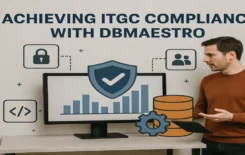What You’ll Learn
- Essential best practices for ensuring database compliance and security.
- How to safeguard your organization’s data from potential breaches and unauthorized access.
- Practical steps for implementing encryption, firewalls, and other critical security controls.
- The importance of regular audits and proactive security measures for database compliance.
However, doing so can prove to be challenging due to the rapid scaling up of operations, globalization with multiple teams working out of multiple branches, outsourcing, and the dynamic nature of the regulatory compliance rules across the globe, something that requires constant adjustments.
This blog post will cover the top 10 database compliance best practices that your organization should ideally adopt, implement, and monitor immediately.
Database Compliance: The Challenges
Besides the obvious legal and monetary implications, adhering to the latest compliance standards has become extremely critical in creating a sustainable business model. The traditional security features offered by database vendors are no longer enough to get the job done. The threat landscape has evolved.
What are the traditional security features? Perimeter defenses such as firewalls, which are typically based on signatures that hackers can easily bypass, are proving to be inadequate due to the sophisticated nature of the threats posed to databases and the specific nature of their vulnerabilities.
The same goes for native DBMS auditing. Database management systems have the ability to write audit logs for transactions. However, organizations tend to avoid taking this route due to the detrimental effect they have on database performance and the amount of storage they require for full auditing.
Furthermore, open logs are inadequate since they can be manipulated. Also, privileged (and malicious) users can turn the audit function on and off.
Database management systems are also growing in complexity, making them more vulnerable to attacks. These vulnerabilities range from the relatively benign to weaknesses that allow unauthorized users to bypass the built-in access control mechanism, escalate access privileges, and hijack databases.
Top 10 Database Compliance Best Practices
As mentioned earlier, the compliance landscape has evolved and changed the way databases need to be managed. Here are the top database security and compliance best practices you should be implementing so safeguard your customers data and avoid breaches that can damage or even shut down your business.
1 – Everything Starts with Training
Admins and other relevant stakeholders should receive constant training about the latest compliance rules. They should have adequate knowledge, technical knowhow, and an understanding of all security requirements, with access to configuration standards and supporting internal documentation.
Pro Tip: Conduct regular refresher courses to keep teams updated on the latest compliance changes and security threats.
2 – Adopt The “Least Privilege” Philosophy
The “Least Privilege” philosophy calls for users and applications to have only the minimal privileges they actually require to function properly.
Some organizations grant deep privileges to temporary workers but forget to remove or change privileges when the work is done. These privileges are often exploited via underlying vulnerabilities. Apply restrictions when granting users access to the database and review access privileges periodically.
3 – Implement Secure Coding Practices
Many database vulnerabilities are exposed due to the way applications are coded and the way they interact with the database. Architecting and designing for security, validating input, and sanitizing data sent to other systems are some of the recommended methods used in secure coding.
Lack of accountability and lack of secure coding practices often lead to data breaches. For example, SQL Injection risks can be eliminated by binding variables in SQL statements. Unfortunately, many developers still don’t use this method, leaving the database exposed to SQL Injections.
4 – Usernames and Passwords
Duping the user authentication mechanism is still one of the easiest ways to penetrate databases. Oracle and other databases come with built-in default usernames and passwords created to make it easier to set up the system. These should be erased after the system has been set up to avoid any loopholes.
Pro Tip: Implement multi-factor authentication (MFA) alongside strong passwords to add an extra layer of protection against unauthorized access.
Weak passwords, including short ones based on dictionary words or names, and dates, are a huge risk. There are free online tools that can crunch through hundreds of thousands of passwords per minute. Hence, it’s imperative to use strong passwords that contain a combination of letters, numbers, and symbols.
5 – Maximize Security Controls
Always make sure you are running the latest version of your database software to minimize vulnerabilities. Turn on all security protocols and controls of your database and website server. Also, delete or disable unnecessary features and services, while changing all default passwords to prevent unauthorized access.
6 – Separate Servers and Web Servers
Separate your database server from your website server to enhance database security. Keeping your servers separate will increase the security levels of your database server and website so that even if your web server admin account is compromised, hackers won’t be able to access your database.
Keep unnecessary programs and servers separate from servers that don’t require them to operate. While these servers may need to communicate, make sure that their permissions are confined to the lowest level of privilege needed. This will limit the scope of damage an attacker can inflict.
7 – Encrypt All Files and Backups
Cyber criminals are the primary threat to your database’s security, but you need to look at the bigger picture and prepare for unpleasant surprises. Your employees can also pose a significant security risk. There is always the chance that an internal stakeholder will be involved in unauthorised activity.
Encrypting your data makes it unreadable to hackers and unauthorized employees without an encryption key, effectively turning it into a final line of defense against malicious access. Encrypt all important documents, files, and backups to keep sensitive data away from the “bad guys”.
Did You Know?
As per hipaajournal.com, there were over 500 healthcare
data breaches of 500 or more records in 2019.
8 – Use Database and Web Application Firewalls
In a nutshell, firewalls enhance database security by denying traffic and minimizing threats. When properly configured, they only allow traffic from predefined applications or web servers that need to access the data, and prevent your database from initiating unauthorised outbound connections.
Additionally, implementing a web application firewall helps protect your web servers and increases database security. Without one in place, web application attacks can be executed to harvest data from your database. But having one keeps your database relatively secured and less prone to malicious activity.
9 – Patch it Up
If your database or website uses widgets, plugins and other third-party apps, cyber criminals will often target these in order to bypass your database security, especially if they haven’t been patched or updated on a regular basis.
Be sure to run updates as soon as they become available.
10 – Hack and Audit Your Database
Another way is hacking and auditing your database to check your security status. Therefore, once you feel like you’ve implemented all of the proper security defenses and have covered all of your bases, put your work to the test by trying to hack in yourself with the help of dedicated professionals.
This process should be repeated as frequently as possible because your database is constantly changing and new loopholes are being created.
Final Thoughts
Securing your database and making it fully compliant with the latest regulatory requirements is no longer a matter of using traditional security tools and solutions. You will need to adopt a proactive approach, while instilling (and maintaining) enhanced security awareness in your organization.
Failing to meet regulatory requirements can make the difference between remaining in business or going bankrupt. Take control now.
Key Takeaways
- Database compliance is essential to safeguarding customer data and avoiding costly regulatory fines.
- Adopting secure coding practices, limiting access, and using strong passwords reduce vulnerability to attacks.
- Regular audits, updates, and penetration testing are vital for maintaining compliance and security.
- Proactive measures, including encryption and firewalls, strengthen database protection against internal and external threats.





